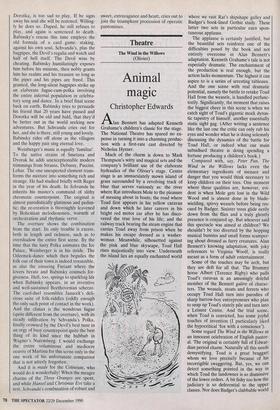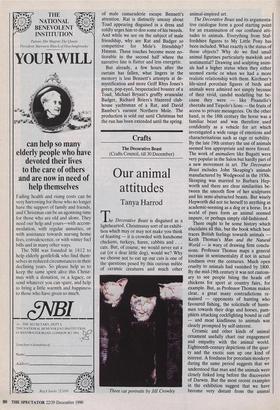Theatre
The Wind in the Willows (Olivier)
Animal magic
Christopher Edwards
Alan Bennett has adapted Kenneth Grahame's children's classic for the stage. The National Theatre has spared no ex- pense in turning it into a charming produc- tion with a first-rate cast directed by Nicholas Hytner.
Much of the charm is down to Mark Thompson's witty and magical sets and the company's brilliant use of the elaborate hydraulics of the Olivier's stage. Centre stage is an immaculately mown island of grass surrounded by a revolving track of blue that serves variously as: the river where Rat introduces Mole to the pleasure of messing about in boats; the road where Toad first appears in his yellow caravan and down which he later careers in his bright red motor car after he has disco- vered the true love of his life; and the railway track bearing the steam engine that carries Toad away from prison when he makes his escape dressed as a washer- woman. Meanwhile, silhouetted against the pink and blue sky scape, Toad Hall rises majestically into view. Underneath the island lies an equally enchanted world where we visit Rat's shipshape galley and Badger's book-lined Gothic study. These latter two sets in particular earn spon- taneous applause.
The applause is certainly justified, but the beautiful sets reinforce one of the difficulties posed by the book and not entirely overcome in Alan Bennett's adaptation. Kenneth Grahame's tale is not especially dramatic. The enchantment of the production is real enough, but the action lacks momentum. The highest it can aspire to is a series of arresting tableaux. And the one scene with real dramatic potential, namely the battle to retake Toad Hall from the weasels, is handled perfunc- torily. Significantly, the moment that raises the biggest cheer in this scene is when we catch sight of Toad's gigantic mock dynas- tic tapestry of himself, another essentially static sight gag. (After writing a sentence like the last one the critic can only rub his eyes and wonder what he is doing solemnly discussing the dynamics of the battle for Toad Hall, or indeed what our main subsidised theatre is doing spending a fortune producing a children's book.) Compared with, say, Peter Pan, The Wind in the Willows lacks even the elementary ingredients of menace and danger that you would think necessary to keep children on their toes. One moment where these qualities are, however, evi- dent is when Mole gets lost in the Wild Wood and is almost done in by blade- wielding, spivvy weasels before being res- cued by Badger. Sinister trees glide eerily down from the flies and a truly ghostly presence is conjured up. But whoever said this spectacle was aimed at children? We shouldn't be too diverted by the hopping musical bunnies and small forms scamper- ing about dressed as furry creatures. Alan Bennett's knowing adaptation, with joky references to Virginia Woolf, is really meant as a form of adult entertainment.
Some of the touches may be arch, but they are deft for all that. The Brummy horse Albert (Terence Rigby) who pulls Toad's caravan is an amusingly doleful member of the Bennett galere of charac- ters. The weasels, stoats and ferrets who occupy Toad Hall turn into parodies of sharp barrow-boy entrepreneurs who plan to snap up Toad's stately pile and turn into a Leisure Centre. And the trial scene, when Toad is convicted, has some joyful touches of invention (I particularly liked the hypocritical 'fox with a conscience').
Some regard The Wind in the Willows as an innocent celebration of English pastor- al. The original is certainly full of Edwar- dian period charm. Naturally all this needs demystifying. Toad is a great braggart whom we love precisely because of his incorrigible swaggering. But, yes, we can detect something pointed in the way in which Toad the landowner is so dismissive of the lower orders. A bit fishy too how the judiciary is so deferential to the upper classes. Nor does Badger's clubbable world of male camaraderie escape Bennett's attention. Rat is distinctly uneasy about Toad appearing disguised in a dress and coldly urges him to don some of his tweeds. And while we are on the subject of male friendship, why are Rat and Badger so competitive for Mole's friendship? Hmmm. These touches become more no- ticeable in the second half where the narrative line is flatter and less energetic.
But already, a few hours after the curtain has fallen, what lingers in the memory is less Bennett's attempts at de- mystification and more Griff Rhys Jones's green, pop-eyed, bespectacled boaster of a Toad, Michael Bryant's gruffly avuncular Badger, Richard Briers's blazered club- house yachtsman of a Rat, and David Bamber's earnest Northern Mole. The production is sold out until Christmas but the run has been extended until the spring.



































































































 Previous page
Previous page